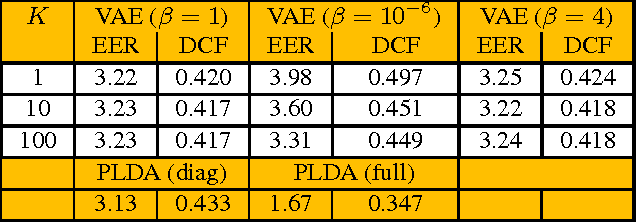Timur Pekhovsky
STC speaker recognition systems for the NIST SRE 2021
Nov 03, 2021



Abstract:This paper presents a description of STC Ltd. systems submitted to the NIST 2021 Speaker Recognition Evaluation for both fixed and open training conditions. These systems consists of a number of diverse subsystems based on using deep neural networks as feature extractors. During the NIST 2021 SRE challenge we focused on the training of the state-of-the-art deep speaker embeddings extractors like ResNets and ECAPA networks by using additive angular margin based loss functions. Additionally, inspired by the recent success of the wav2vec 2.0 features in automatic speech recognition we explored the effectiveness of this approach for the speaker verification filed. According to our observation the fine-tuning of the pretrained large wav2vec 2.0 model provides our best performing systems for open track condition. Our experiments with wav2vec 2.0 based extractors for the fixed condition showed that unsupervised autoregressive pretraining with Contrastive Predictive Coding loss opens the door to training powerful transformer-based extractors from raw speech signals. For video modality we developed our best solution with RetinaFace face detector and deep ResNet face embeddings extractor trained on large face image datasets. The final results for primary systems were obtained by different configurations of subsystems fusion on the score level followed by score calibration.
Deep Speaker Embeddings for Far-Field Speaker Recognition on Short Utterances
Feb 14, 2020



Abstract:Speaker recognition systems based on deep speaker embeddings have achieved significant performance in controlled conditions according to the results obtained for early NIST SRE (Speaker Recognition Evaluation) datasets. From the practical point of view, taking into account the increased interest in virtual assistants (such as Amazon Alexa, Google Home, AppleSiri, etc.), speaker verification on short utterances in uncontrolled noisy environment conditions is one of the most challenging and highly demanded tasks. This paper presents approaches aimed to achieve two goals: a) improve the quality of far-field speaker verification systems in the presence of environmental noise, reverberation and b) reduce the system qualitydegradation for short utterances. For these purposes, we considered deep neural network architectures based on TDNN (TimeDelay Neural Network) and ResNet (Residual Neural Network) blocks. We experimented with state-of-the-art embedding extractors and their training procedures. Obtained results confirm that ResNet architectures outperform the standard x-vector approach in terms of speaker verification quality for both long-duration and short-duration utterances. We also investigate the impact of speech activity detector, different scoring models, adaptation and score normalization techniques. The experimental results are presented for publicly available data and verification protocols for the VoxCeleb1, VoxCeleb2, and VOiCES datasets.
STC Speaker Recognition Systems for the VOiCES From a Distance Challenge
Apr 12, 2019



Abstract:This paper presents the Speech Technology Center (STC) speaker recognition (SR) systems submitted to the VOiCES From a Distance challenge 2019. The challenge's SR task is focused on the problem of speaker recognition in single channel distant/far-field audio under noisy conditions. In this work we investigate different deep neural networks architectures for speaker embedding extraction to solve the task. We show that deep networks with residual frame level connections outperform more shallow architectures. Simple energy based speech activity detector (SAD) and automatic speech recognition (ASR) based SAD are investigated in this work. We also address the problem of data preparation for robust embedding extractors training. The reverberation for the data augmentation was performed using automatic room impulse response generator. In our systems we used discriminatively trained cosine similarity metric learning model as embedding backend. Scores normalization procedure was applied for each individual subsystem we used. Our final submitted systems were based on the fusion of different subsystems. The results obtained on the VOiCES development and evaluation sets demonstrate effectiveness and robustness of the proposed systems when dealing with distant/far-field audio under noisy conditions.
Investigation of Using VAE for i-Vector Speaker Verification
May 25, 2017



Abstract:New system for i-vector speaker recognition based on variational autoencoder (VAE) is investigated. VAE is a promising approach for developing accurate deep nonlinear generative models of complex data. Experiments show that VAE provides speaker embedding and can be effectively trained in an unsupervised manner. LLR estimate for VAE is developed. Experiments on NIST SRE 2010 data demonstrate its correctness. Additionally, we show that the performance of VAE-based system in the i-vectors space is close to that of the diagonal PLDA. Several interesting results are also observed in the experiments with $\beta$-VAE. In particular, we found that for $\beta\ll 1$, VAE can be trained to capture the features of complex input data distributions in an effective way, which is hard to obtain in the standard VAE ($\beta=1$).
 Add to Chrome
Add to Chrome Add to Firefox
Add to Firefox Add to Edge
Add to Edge